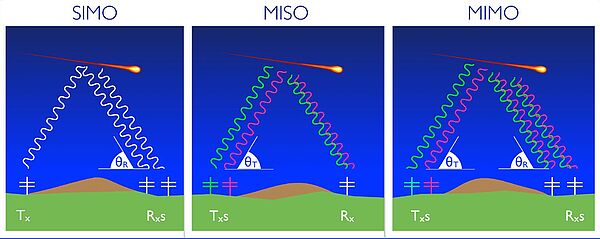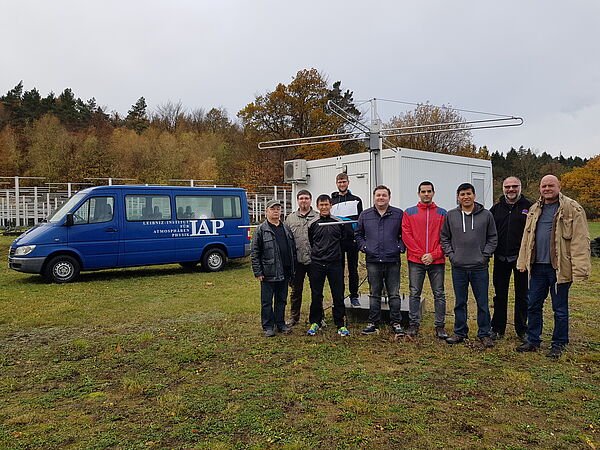SIMONe performed perfect
New technology monitored 500 x 500 km mesospheric dynamics over 7 days
Kühlungsborn, 15 November 2018
This campaign is the first large scale deployment of the Spread-spectrum Interferometric multistatic Meteor radar Observing Network (SIMONe) that has been developed at IAP in conjunction with University of Tromso in Norway and Massachusetts Institute of Technology. It yields the largest daily meteor trail echo count over a geographic area ever recorded - allowing mesospheric dynamics to be studied at higher spatial and temporal resolution than before.
SIMONe consisted of 8 stations (3 of them with transmitter capabilities) distributed over Germany and Denmark, which allow to analyze 12 multistatic links over 7 days. The mutual combination of a variety of phase-coded radar signals allows for the detection of about 200,000 meteor trails per day. This interferometric and multistatic information is processed to get mesospheric wind fields at about 80 km including structure functions. Project leader Prof. Jorge Luis Chau says: “This unique data set is the result of novel engineering efforts from the last couple of years, including 2 Bachelor, 3 Master, 1 Ph.D. thesis, and 4 publications in international journals. Although the main objective of this campaign was to test engineering and practical aspects of our novel developments, we envision that the dataset will be exploited scientifically in both atmospheric as well as meteor topics. Based on the preliminary excellent results, this is the type of systems that we will be deploying in the incoming years in northern Norway, central Peru, and southern part of South America, to study the mesospheric dynamics with unprecedented spatial and temporal resolutions and coverage, under different atmospheric conditions.”
The SIMONe team thanks the following persons for helping us install and operated the MISO links in their properties: Rüdiger Lange (Salzwedel), Fred and Cladia Bauske (Mechelsdorf), Frank Schütz (Gulderup, Denmark), and Dieter Keuer (Breege). The SIMONe activities has been partially supported by the Deutsche Forschungsgemeinschaft (DFG, German Research Foundation) under SPP 1788 (CoSIP)-CH1482/3-1, by the WATILA Project (SAW-2015-IAP-1), and NSF Major Research Infrastructure grant AGS-1626041. Further information on the campaign can be retrieved from http://www.radio-science.net/2018/11/simone-campaign-2018.html and http://www.radio-science.net/2018/11/simone-2018-campaign-update.html .
The Leibniz-Institute of Atmospheric Physics is one of the German main centers for Middle Atmosphere research and The Leibniz-Institute is one of the German main centers for Middle Atmosphere research and maintains active cooperations with several international research organizations. The institute is located near the Baltic Sea resort Kühlungsborn, owns a separate site on the island Rügen, and is a major partner of the ALOMAR observatory in northern Norway. As associated institute of the Rostock University it is part of the teaching programme in physics. A total of about 90 persons is employed at IAP. The institute realizes an equal-opportunity and family-friendly human resource policy and is certified with the audit "berufundfamilie"
('career and family').
Contacts: Director Prof. Franz-Josef Lübken luebken@ iap-kborn.de ; Project leader Prof. Jorge L. Chau chau@
iap-kborn.de ; Project leader Prof. Jorge L. Chau chau@ iap-kborn.de
iap-kborn.de














